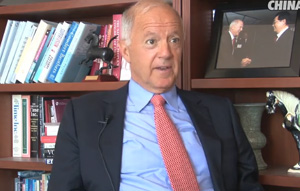Dilating the vista of the future
Updated: 2013-06-08 07:56
By Chen Xiaoyang (China Daily)
|
|||||||||||
Caribbean and Latin American nations have great potential for trade cooperation and can become China's strategic partners
President Xi Jinping's visits to Trinidad and Tobago, Costa Rica and Mexico from May 31 to June 6, and Vice-President Li Yuanchao's tour of Argentina and Venezuela in early May have opened a new chapter in China's relations with the Caribbean and Latin America. The visits reflect the new Chinese leadership's multidimensional, multi-level "grand diplomacy" strategy, too.
Trinidad and Tobago is one of the founding members of the Caribbean Community and the Association of Caribbean States. In a way, the country is the energy, industrial and financial hub of the Caribbean region.
In 1971, Trinidad and Tobago voted in favor of restoring the lawful seat of the People's Republic of China in the United Nations and established diplomatic ties with the PRC in 1974, becoming one of the first Caribbean countries to do so. That's why, despite its small size, China regards Trinidad and Tobago as the "bellwether" of Caribbean countries and a model of China-Caribbean relations.
During his visit to Port of Spain, capital of Trinidad and Tobago, Xi presented a four-point proposal -that the two sides enhance high-level interaction; expand cooperation in sectors such as infrastructure construction, energy, mining, tourism and financial services; increase people-to-people exchanges; and strengthen coordination in international affairs.
The two countries have agreed to set up a Confucius Institute in Trinidad and Tobago in order to improve cultural exchanges and mutual understanding. They have also agreed to jointly celebrate the 40th anniversary of bilateral diplomatic relations next year.
China understands Trinidad and Tobago's concerns over climate change and has promised to support small island states' stance at climate negotiations. Moreover, as part of its responsibility as a big power, China is working out ways to supply energy-saving products to Caribbean countries to help them adapt to as well as fight climate change.
In Port of Spain, Xi also met the presidents of Guyana and Suriname, and the prime ministers of Antigua and Barbuda, Dominica, Grenada, the Bahamas, Jamaica and Barbados, and agreed to provide about $3 billion in loans to 10 Caribbean nations and Costa Rica apart from sending medical personnel to the region on condition that they stood by the one-China policy and refused to support Taiwan separatists.
Costa Rica is the second country Xi visited on his trip to the Caribbean and Latin America, and it is the only country in Central America to have diplomatic relations with China. A politically stable country with a well-developed economy, Costa Rica will assume the rotating chair of the Community of Latin American and Caribbean States next year and is likely to promote overall cooperation between Latin America and China.
China and Costa Rica established diplomatic ties in 2006 and signed a free trade agreement in 2011, and their relationship has the potential of becoming a model of bilateral cooperation. During Xi's visit to Costa Rica, the two sides signed agreements on economic and technological cooperation, quality inspection of pork products exported to China, construction of a joint oil refinery on Costa Rica's Caribbean coast, and Chinese funding for the expansion of one of Costa Rica's strategic highways.
China supports Costa Rica's efforts to build a special economic zone, while the Costa Rican government welcomes Chinese enterprises to invest in its country. In this regard, the two sides agreed to work for the establishment of a China-Latin America cooperation forum.
Xi's visits to countries which are small in size but important in diplomatic aspects reflect Beijing's renewed efforts to balance its diplomacy between developed and developing countries, "big" and "small" nations, and Eastern and Western hemispheres.
The new Chinese leadership's diplomatic moves reflect its emphasis on Latin America and the Caribbean countries, which have great potential for trade cooperation and can become China's strategic partners because of their common national interests, close development levels and similar global aspirations.
President Xi's visits to the Caribbean and Latin America, preceded by Vice-President Li's trip to South America, are part of China's multidimensional diplomatic layout for the region. Their trips, along with US President Barack Obama's visit to Mexico and Costa Rica in early May and US Vice-President Joe Biden's six-day tour of Latin America, which included Trinidad and Tobago, Colombia and Brazil, show the great importance they attach to the region.
After wrapping up his three-nation tour, Xi is now in California discussing with Obama the establishment of a new type of relationship between the two major powers, which is of great bilateral and global significance.
The author is a research scholar at the Institute of Latin American Studies, affiliated to the China Institutes of Contemporary International Relations.
(China Daily 06/08/2013 page5)
Today's Top News
Stakes high ahead of Xi-Obama summit
5.9-magnitude quake jolts Taiwan: CENC
42 dead in SE China bus fire
3 missing after Shanghai cargo ships capsize
Gaokao opened to migrant students
Arrest puts focus on school recruits
Xi arrives in California for summit with Obama
Probe of EU wine 'not retaliation'
Hot Topics
Lunar probe , China growth forecasts, Emission rules get tougher, China seen through 'colored lens', International board,
Editor's Picks

|

|

|

|

|

|





